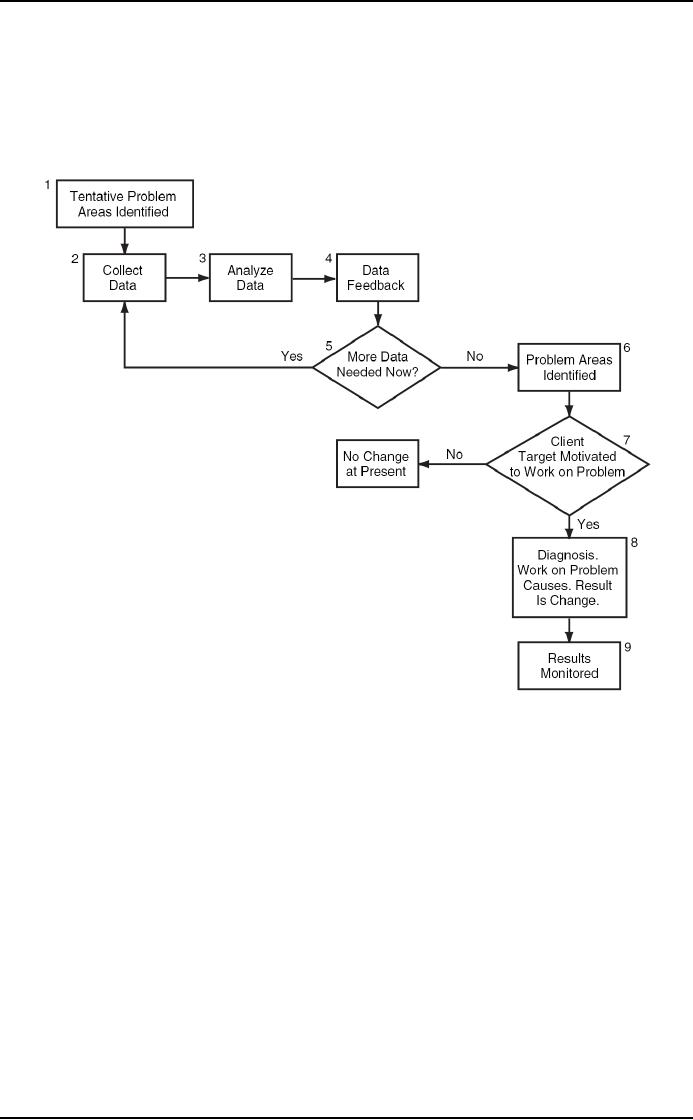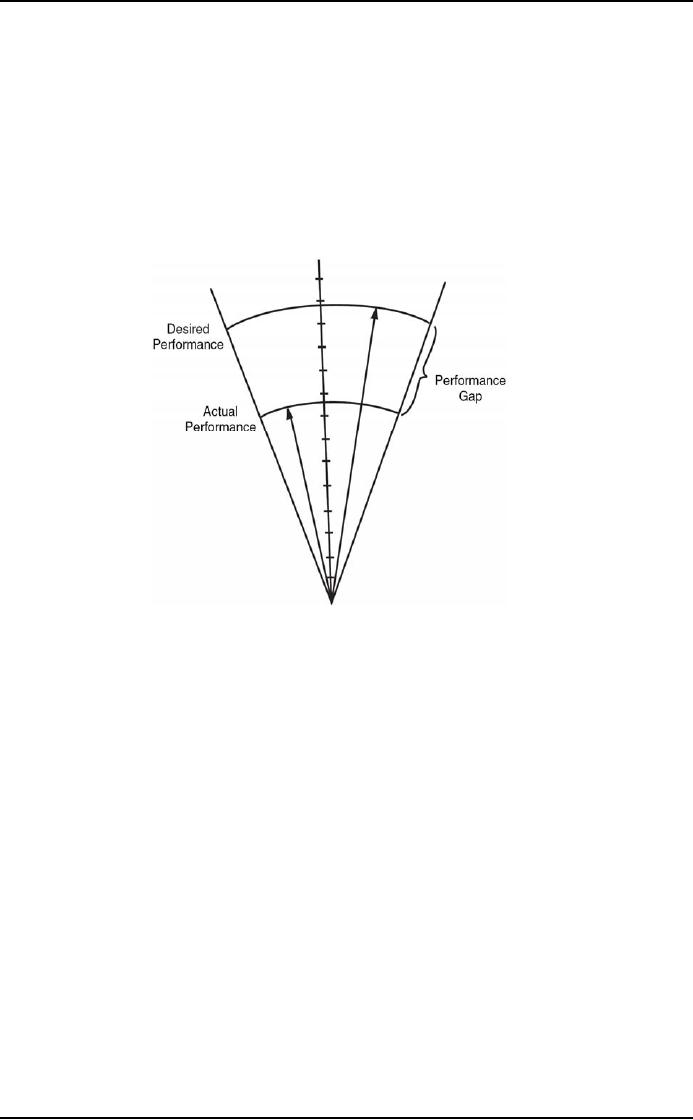 |

Organization
Development MGMT
628
VU
Lesson
15
Diagnosing
Organizations
All
consultants advocate expert diagnosis
and action-taking. Engineers and
behavioral scientists alike have
diagnoses
of organizational conflict and prescription
for solving it. Diagnosis
is
medical jargon for the
gap
between
sickness and health. As biology exploded
in the late 19th century, the human body,
like the
workplace,
was divided into manageable
components, too. Doctors
became the industrial engineers of
the
human
physique. Their claim of
expertise was based on their
ability to factor in every relevant
"variable"
and
thus heal the sick.
It
is no surprise that, applying to
industrial science, diagnosis is
conceived as identifying and
closing gaps
between
how things are and how they
should be, using all the
tools of science and
technology.
Lewin
added a new dimension to this model. He
highlighted processes unseen
through 19th-century
eyes
because
nobody had a conceptual lens
powerful enough.
The
concept he developed goes by the name of
the "task/process"
relationship the
subtle chicken/egg
interplay
between ends and means,
methods and goals. A task is
something concrete, observable,
and thing-
oriented.
It can be converted into criteria,
measurements, targets, and
deadlines.
A task
group dynamics
people
were fond of saying
refers to what is to be done.
Process
refers to how. It reflects
perceptions, attitudes, reasoning.
Process diagnosticians ask,
"Why aren't
we
making progress?" They don't ask
when, where, and how
many but why, how,
and whether.
Task/process
thinking can be likened to the
famous visual paradox of the Old
Woman/Young Woman.
Do
you see a young beauty with
her head turned or an old
woman in profile?
Figure
18: Old woman/young
girl
You
can't see both at once. By
some mental gyration, you
can learn to shift between
them.
Action,
on the other hand, reflects pure
process. We guide it largely on
automatic pilot, fueled by
little
explosions
of energy in the right brain of
creativity, insight, synthesis that
can't be quantified or
specified
as "targets."
Through
trained observation, you can diagnose
ingenious linkages between task
and process. When
work
stops,
for example, determine what is
not being talked about the gap
between word and deed, the
all-too-
human
shortfall between aspiration and action.
You must shift attention the
way a pilot scans
instruments
from
compass to altimeter to air speed
indicator to keep task
and process synchronized.
That requires
skills
few of us learn in school.
Unfortunately,
left-brain diagnostic thinking
perfected by scientists for
more than 100 years
leads
people
to pay attention to the compass
and to consider the altimeter a frill.
The diagnoser is assumed
to
stand
outside, impartial, "objective," and
aloof from what is observed. If
you add to this your propensity
to
defer
to authority parents, boss,
and experts you have a
setup for disappointment. For
the
authority/dependency
relationship itself becomes a "process"
issue, especially when the
person invested
with
abilities lacks satisfactory
"answers."

Organization
Development MGMT
628
VU
Group
dynamics' great contribution to
management was its
relentless gaze at the process as
inseparable
from
the task, the diagnoser inseparable
from the diagnosis, a leader's
effectiveness inseparable
from
follower
contributions.
What
is Diagnosis?
Diagnosis
is the process of understanding how the
organization is currently functioning, and it provides
the
information
necessary to design change
interventions. It generally follows
from successful entry
and
contracting,
which set the stage for
successful diagnosis. They
help OD practitioners and client
members
jointly
determine organizational issues to focus
on, how to collect and
analyze data to understand
them,
and
how to work together to develop action
steps from the
diagnosis.
Unfortunately,
the term diagnosis can be misleading when
applied to organizations. It suggests a model
of
organization
change analogous to medicine: an
organization (patient) experiencing problems
seeks help
from
an OD practitioner (doctor); the practitioner
examines the organization, finds the
causes of the
problems,
and prescribes a solution.
Diagnosis in organization development, however, is
much more
collaborative
than such a medical
perspective implies and does
not accept the implicit
assumption that
something
is wrong with the organization.
First,
the values and ethical
beliefs that underlie OD suggest
that both organization members
and change
agents
should be involved in discovering the
determinants of current organizational effectiveness.
Similarly,
both
should be involved actively in developing appropriate
interventions and implementing them.
For
example,
a manager might seek OD help
to reduce absenteeism in his or
her department. The manager
and
an
OD consultant jointly might decide to
diagnose the cause of the problem by
examining company
absenteeism
records and by interviewing
selected employees about possible
reasons for
absenteeism.
Alternatively,
they might examine employee
loyalty and discover the organizational
elements that
encourage
people
to stay. Analysis of those
data could uncover determinants of
absenteeism or loyalty in the
department,
thus helping the manager and
the practitioner to develop an appropriate
intervention to
address
the issue. The choice about
how to approach the issue of
absenteeism and the decisions about
how
to
address it are made jointly
by the OD practitioner and the
manager.
Second,
the medical model of diagnosis also
implies that something is
wrong with the patient and
that one
needs
to uncover the cause of the illness. In
those cases where
organizations do have specific
problems,
diagnosis
can be problem oriented, seeking
reasons for the problems. On the
other hand, as suggested
by
the
absenteeism example above, the
practitioner and the client
may choose to frame the
issue positively.
Additionally,
the client and OD practitioner
may be looking for ways to
enhance the organization's existing
functioning.
Many managers involved with
OD are not experiencing
specific organizational problems.
Here,
diagnosis is development oriented. It assesses the
current functioning of the organization to
discover
areas
for future development. For
example, a manager might be
interested in using OD to improve
a
department
that already seems to be
functioning well. Diagnosis might include
an overall assessment of
both
the task-performance capabilities of the department
and the impact of the department on
its
individual
members. This process seeks
to uncover specific areas for
future development of the
department's
effectiveness.
In
organization development, diagnosis is used
more broadly than a medical
definition would suggest. It
is
a
collaborative process between organization
members and the OD consultant to collect
pertinent
information,
analyze it, and draw
conclusions for action planning
and intervention. Diagnosis
may be aimed
at
uncovering the causes of specific
problems; be focused on understanding
effective processes; or be
directed
at assessing the overall functioning of
the organization or department to discover areas
for future
development.
Diagnosis provides a systematic understanding of
organizations so that appropriate
interventions
may be developed for solving problems
and enhancing
effectiveness.
Organizational
diagnosis is a major practitioner skill.
It usually examines two broad
areas.
The
first area comprises
the various interacting sub-elements that
make up the organization. These
include
the
divisions, departments, products, and the
relationships between them. The
diagnosis may also include
a
comparison
of the top middle, and lower
levels of management in the
organization.
The
second area of
diagnosis concerns the organizational
processes. These include
communication
networks,
team problem-solving, decision-making,
leadership and authority
styles, goal-setting and
planning
methods,
and the management of conflict
and competition.
The
Process:
Diagnosis
is a cyclical process that
involves data gathering, interpretations,
and identification of
problem
areas
and possible action programs, as
shown in Figure 19. The
first step is the preliminary
identification of
possible
problem areas. These
preliminary attempts often
bring out symptoms as well
as possible problem
areas.

Organization
Development MGMT
628
VU
The
second step involves gathering
data based on the preliminary
problem identified in the preceding
step.
These
data are categorized,
analyzed and presented to the
client in a feedback session
(steps 3 and 4). If it
is
determined
that enough data are
available (step 5), the
client and practitioner
jointly diagnose and
identify
likely
problem areas (step 6). At
this point, the client's level of
motivation to work on the problems
is
determined
(step 7). Based upon the
diagnosis, the target systems
are identified and the
change strategy is
designed
(step 8). Finally (step
9), the results are
monitored to determine the degree of
change that has
been
attained versus the desired change
goals.
Fig
19: The Diagnostic
Process
The
Performance Gap:
One
method in the diagnostic process is to
determine the performance
gap---the difference
between
what
the organizations could do by virtue of
its opportunity in its
environment and what it actually
does.
This
leads to an approach that
may be termed gap analysis.
In this method, data are collected on the
actual
state
of the organization on a varying set of dimensions
and also on the ideal or
desired state, that
is,
"where
the organization should be. As shown in Figure
20, the gap, or discrepancy,
between the actual
state
and
the ideal form a basis for
diagnosis and the design of
interventions. The gap may
be the result of
ineffective
performance by internal units or may
emerge because of competitive changes or
new
innovations.
A performance gap may also
occur when the organization fails to
adapt to changes in
its
external
environment.
Competent
organizational diagnosis does not simply
provide information about the system; it
is also helpful
in
designing and introducing action
alternatives for correcting possible
problems. The diagnosis affirms
the
need
for change and the benefits of
possible changes in the client
system. Important problems
are very
often
hidden or obscure, whereas the
more conspicuous and obvious
problems are relatively
unimportant.
In
such situations, dealing
with the obvious may not be
a very effective way to manage change;
this
underscores
the importance of the diagnostic
stage.
A
performance gap may continue
for some time before it is recognized, in
fact, it may never be
recognized.
On
the other hand, the awareness of a
performance gap may unfreeze
the functions within the
organization
that
are most in need of change.
When this happens, conditions
are present for altering the
structure and
function
of the organization by introducing OD
interventions.

Organization
Development MGMT
628
VU
One
OD practitioner suggests a self
assessment version of gap analysis
using questionnaires to
gather
information
in four key areas:
1.
The organization's strengths.
2.
What can be done to take
advantage of the strengths?
3.
The organization's weaknesses.
4.
What can be done to alleviate the
weaknesses?
In
organizational diagnosis, the practitioner is
looking for causality
that is, an implication that
change in
one
factor (such as compensation)
will cause change in another
factor (productivity): a
cause-effect
relationship.
The client is often aware of
the evidence of the problem, such as declining
sales, high
turnover,
or loss of market share the
symptom of a problem. In the diagnosis
phase, the practitioner
tries
to
identify what factors are
causing the problem, and therefore what
needs to be changed to fix
it.
Fig
20: The Performance Gap
The
process of identifying the
organization's strengths
and
weaknesses
often
leads
to
recognition
of performance gaps and to
change programs.
The
Need for Diagnostic
Models:
Entry
and contracting processes can
result in a need to understand a
whole system or some part,
process,
or
feature of the organization. To diagnose an
organization, OD practitioners and organization
members
need
to have an idea about what
information to collect and analyze.
Choices about what to look
for
invariably
depend on how organizations
are perceived. Such
perceptions can vary from
intuitive hunches to
scientific
explanations of how organizations
function. Conceptual frameworks
that people use to
understand
organizations are referred to as
diagnostic models. They
describe the relationships among
different
features of the organization, its context,
and its effectiveness. As a
result, diagnostic models
point
out
what areas to examine and what
questions to ask in assessing
how an organization is
functioning.
However
all models represent simplifications of
reality and therefore choose certain
features as critical.
Focusing
attention on those features,
often to the exclusion of others,
can result in a biased
diagnosis. For
example,
a diagnostic model that relates
team effectiveness to the handling of
interpersonal conflict would
lead
an OD parishioner to ask questions about
relationships among members,
decision-making processes,
and
conflict resolution methods.
Although relevant, those questions ignore
other group issues such as
the
composition
of skills and knowledge, the complexity
of the tasks performed by the group, and
member
inter-dependencies.
Thus, diagnostic models must
be chosen carefully to address the
organization's
presenting
problems as well as to ensure
comprehensiveness.
Potential
diagnostic models are
everywhere. Any collection of
concepts and relationships that
attempts to
represent
a system or explain its
effectiveness can potentially
qualify as a diagnostic model. Major
sources
of
diagnostic models in OD are the
thousands of articles and books
that discuss, describe, and
analyze how
organizations
function. They provide information about
how and why certain
organizational systems,
processes,
or functions are effective. The
studies often concern a
specific facet of organizational
behavior,

Organization
Development MGMT
628
VU
such
as employee stress, leadership,
motivation, problem solving, group
dynamics, job design, and
career
development
they also can involve the
larger organization and its
con text, including the
environment,
strategy,
structure, and culture. Diagnostic models
can be derived from that
information by noting the
dimensions
or variables that are
associated with organizational
effectiveness.
Another
source of diagnostic models is OD
practitioners' experience in organizations.
That field
knowledge
is a wealth of practical information about
how organizations operate.
Unfortunately only a
small
part
of that vast experience has
been translated into
diagnostic models that
represent the professional
judgments
of people with years of experience in
organizational diagnosis. The models
generally link
diagnosis
with specific organizational processes,
such as group problem solving,
employee motivation, or
communication
between managers and
employees. The models list
specific questions for
diagnosing such
processes.
Let's
look at a general framework for
diagnosing organizations. The
framework describes the
systems
perspective
prevalent in OD today and integrates
several of the more popular
diagnostic models.
The
systems
model provides a useful starting point
for diagnosing organizations or
departments.
Open-Systems
Model:
This
section introduces systems
theory, a set of concepts
and relationships describing the properties
and
behaviors
of things called systems - organizations,
groups, and people, for
example. Systems are viewed
as
unitary
wholes composed of parts or
subsystems; the system serves to
integrate the parts into a
functioning
unit.
For example, organization systems
are composed of departments
such as sales, operations,
and
finance.
The organization serves to coordinate
behaviors of its departments so
that they function together
in
service of a goal or strategy.
The general diagnostic model
based on systems theory that
underlies most
of
OD is called the open -systems
model.
Organization
as Open Systems:
Systems
can vary in how open they are to
their outside environments. Open
systems, such as
organizations
and
people, exchange information
and resources with their
environments. They cannot completely
control
their
own behavior and are
influenced in part by external forces.
Organizations, for example,
are affected
by
such environmental conditions as the
availability of raw material,
customer demands, and
government
regulations.
Understanding how these external forces
affect the organization can help explain
some of its
internal
behavior.
Open
systems display a hierarchical ordering.
Each higher level of system comprises
lower-level systems:
systems
at the level of society comprise
organizations; organizations comprise
groups (departments);
and
groups
comprise individuals. Although
systems at different levels vary in
many ways--in size
and
complexity,
for example--they have a number of common
characteristics by virtue of being open
systems,
and
those properties can be applied to
systems at any level. The
following key properties of open
systems
are
described below: inputs, transformations, and outputs;
boundaries; feedback; equifinality;
and
alignment.
Case:
The Old Family
Bank
The
Old Family Bank is a large bank in a
southeastern city. As a part of a
comprehensive internal
management
study, H. Day, the data-processing
vice-president, examined the turnover,
absenteeism, and
productivity
figures of all the bank's
work groups. The results
Day obtained offered no real
surprises except
in
the case of the check-sorting and
data-processing departments.
The
study
The
study revealed that, in general, the
departments displaying high turnover
and absenteeism rates had
low
production
figures, and those with
low turnover and absenteeism
were highly productive. When
the check-
sorting
and data-processing figures
were analyzed, Day
discovered that two
departments were tied for
the
lead
for the lowest turnover and
absenteeism figures. What
was surprising was the
check-sorting
department
ranked first as the most
productive unit, whereas the electronic
data-processing department
ranked
last.
This
inconsistency was further
complicated by the fact that the
working conditions for
check-sorting
employees
are very undesirable. They work in a
large open room that is hot
in the summer and cold in
the
winter.
They work alone and operate
high-speed check-sorting machines
requesting a high degree
of
accuracy
and concentration. There is little chance
for interaction because they
take rotating coffee
breaks.
The
computer room is air-conditioned, with a
stable temperature year around: it
has perfect lighting and
is
quiet
and comfortable. Both groups
are known to be highly
cohesive, and the workers in
each department
function
well with one another. This
observation was reinforced by the study's
finding of the low levels
of
turnover
and absenteeism.
The
Interview Data

Organization
Development MGMT
628
VU
In
an effort to understand this phenomenon,
Day decided to interview the
members of both
departments
in
order to gain some insight
into the dynamics of each group's
behavior. Day discovered
that the check-
sorting
department displayed a great deal of
loyalty to the company. Most of the
group members are
unskilled
or semiskilled workers; although they
have no organized union, they
all felt that the company
had
made
special efforts to keep
their wages and benefits in
line with unionized
operations. They knew that
their
work required team effort
and were committed to high
performance.
A
quite different situation
existed in the data-processing
department. Although the workers
liked their
fellow
employees, there was a
uniform feeling among this highly skilled
group that management put
more
emphasis
on production than on staff units. They
felt that the operating departments
had gotten better pay
raises,
and that the wag gap
did not reflect the skill
differences between employees. As a
result, a large
percentage
of the group's members displayed little
loyalty to the company, even
though they were very
close
to one another.
Case
Analysis Form
Name:
____________________________________________
I.
Problems
A.
Macro
1.
____________________________________________________
2.
____________________________________________________
B.
Micro
1.
_____________________________________________________
2.
_____________________________________________________
II.
Causes
1.
_____________________________________________________
2.
_____________________________________________________
3.
_____________________________________________________
III.
Systems affected
1.
Structural
____________________________________________
2.
Psychosocial
__________________________________________.
3.
Technical
______________________________________________
4.
Managerial
_____________________________________________
5.
Goals
and values
__________________________________________
IV.
Alternatives
1.
_________________________________________________________
2.
_________________________________________________________
3.
________________________________________________________
V.
Recommendations
1.
_________________________________________________________
2.
__________________________________________________________
3.
__________________________________________________________
Case
Solution: The Old Family
Bank
I.
Problems
A.
Macro
1.
The
lack of loyalty to the entire bank could
affect the effectiveness (and
profitability) of the bank.
2.
The
bank may have a poor process
for setting pay
policies.
B.
Micro
1.
Though
the personnel in the data-processing department
have a strong team, they are
not
loyal
to the larger organization.
2.
Data-processing
personnel believe that
management does not
appreciate them, their
skills, and
contributions.
3.
Data-processing
personnel may be underpaid when compared
to similar workers in
other
companies.

Organization
Development MGMT
628
VU
II.
Causes
1.
The
skilled workers in the data-processing department do
not recognize all of the
factors that may
affect
pay and rewards.
2.
The
data-processing personnel possibly
has access to more
company-wide information by
virtue
of
the type of work their department does
than do personnel in other
departments. Consequently, they
get
a
portion of the data without understanding
how managers make
decisions based upon
that data.
III.
Systems affected
The
attitude of the data-processing personnel
to the bank likely affects the entire
bank's
operations.
IV.
Alternatives
1.
H.
Day gathers more data to
confirm/disprove initial
diagnosis.
2.
Use
a diagnosis model such as force-field
analysis to better understand the
problem. Working
through
the model may bring to light
ways to change the situation in the
data-processing
department.
3.
Day
checks on regional employment data to
determine if data-processing personnel
are being paid
competitively
with similar workers in
other companies. Adjust pay
if warranted by the data.
4.
Meet
with the department and explain the
bank's procedures and rationale
for how pay levels
are
set.
V.
Recommendations
All
of the alternatives listed above
can be undertaken by Day.
Table of Contents:
- The Challenge for Organizations:The Growth and Relevance of OD
- OD: A Unique Change Strategy:OD consultants utilize a behavioral science base
- What an “ideal” effective, healthy organization would look like?:
- The Evolution of OD:Laboratory Training, Likert Scale, Scoring and analysis,
- The Evolution of OD:Participative Management, Quality of Work Life, Strategic Change
- The Organization Culture:Adjustment to Cultural Norms, Psychological Contracts
- The Nature of Planned Change:Lewin’s Change Model, Case Example: British Airways
- Action Research Model:Termination of the OD Effort, Phases not Steps
- General Model of Planned Change:Entering and Contracting, Magnitude of Change
- The Organization Development Practitioner:External and Internal Practitioners
- Creating a Climate for Change:The Stabilizer Style, The Analyzer Style
- OD Practitioner Skills and Activities:Consultant’s Abilities, Marginality
- Professional Values:Professional Ethics, Ethical Dilemmas, Technical Ineptness
- Entering and Contracting:Clarifying the Organizational Issue, Selecting an OD Practitioner
- Diagnosing Organizations:The Process, The Performance Gap, The Interview Data
- Organization as Open Systems:Equifinality, Diagnosing Organizational Systems
- Diagnosing Organizations:Outputs, Alignment, Analysis
- Diagnosing Groups and Jobs:Design Components, Outputs
- Diagnosing Groups and Jobs:Design Components, Fits
- Collecting and Analyzing Diagnostic information:Methods for Collecting Data, Observations
- Collecting and Analyzing Diagnostic information:Sampling, The Analysis of Data
- Designing Interventions:Readiness for Change, Techno-structural Interventions
- Leading and Managing Change:Motivating Change, The Life Cycle of Resistance to Change
- Leading and managing change:Describing the Core Ideology, Commitment Planning
- Evaluating and Institutionalizing Organization Development Interventions:Measurement
- Evaluating and Institutionalizing Organization Development Interventions:Research Design
- Evaluating and Institutionalizing Organization Development Interventions
- Interpersonal and Group Process Approaches:Group Process
- Interpersonal and Group Process Approaches:Leadership and Authority, Group Interventions
- Interpersonal and Group Process Approaches:Third-Party Interventions
- Interpersonal and Group Process Approaches:Team Building, Team Building Process
- Interpersonal and Group Process Approaches:Team Management Styles
- Organization Process Approaches:Application Stages, Microcosm Groups
- Restructuring Organizations:Structural Design, Process-Based Structures
- Restructuring Organizations:Downsizing, Application Stages, Reengineering
- Employee Involvement:Parallel Structures, Multiple-level committees
- Employee Involvement:Quality Circles, Total Quality Management
- Work Design:The Engineering Approach, Individual Differences, Vertical Loading
- Performance Management:Goal Setting, Management by Objectives, Criticism of MBO
- Developing and Assisting Members:Career Stages, Career Planning, Job Pathing
- Developing and Assisting Members:Culture and Values, Employee Assistance Programs
- Organization and Environment Relationships:Environmental Dimensions, Administrative Responses
- Organization Transformation:Sharing the Vision, Three kinds of Interventions
- The Behavioral Approach:The Deep Assumptions Approach
- Seven Practices of Successful Organizations:Training, Sharing Information